In the German early sound film Das Flötenkonzert von Sanssouci/The Flute Concert of Sans-Souci (Gustav von Ucicky, 1930), Otto Gebühr returned as King Frederick the Great (Friedrich II) of Prussia - and for the first time he speaks on screen. The film depicted the incidents that led to the Seven Years' War. The sets were designed by the art directors Robert Herlth and Walter Röhrig. Location filming took place around the Berlin area including at the Sanssouci Palace in Potsdam. After the premiere, there were fierce protests against the film in Germany.
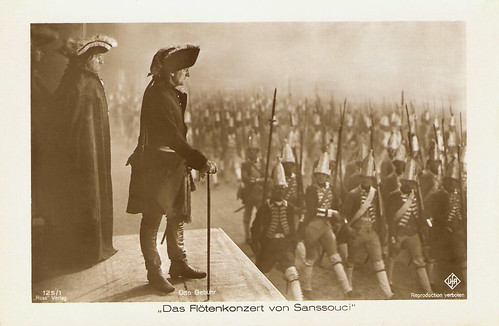
German postcard by Ross Verlag, no. 125/1. Photo: Ufa. Otto Gebühr as Frederick the Great in Das Flötenkonzert von Sanssouci/The Flute Concert of Sans-Souci (Gustav Ucicky, 1930).
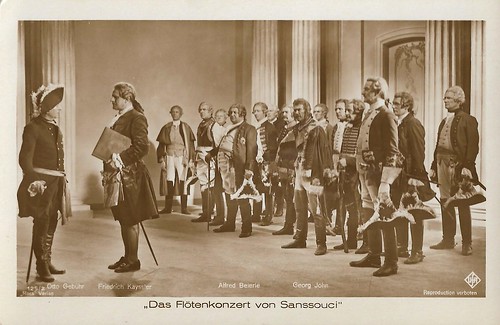
German postcard by Ross Verlag, no. 125/2. Photo: UFA. Publicity still of Das Flötenkonzert von Sanssouci (Gustav von Ucicky, 1930) with Otto Gebühr, Friedrich Kayssler, Alfred Beierie, and Georg John.
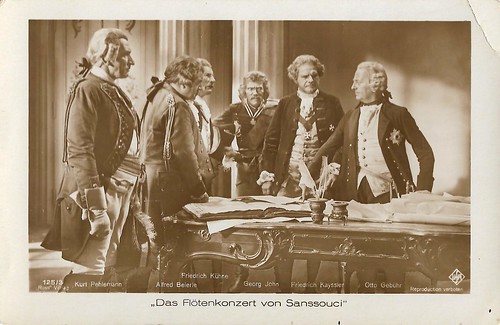
German postcard by Ross Verlag, no. 125/3. Photo: UFA. Publicity still of Das Flötenkonzert von Sanssouci (Gustav von Ucicky, 1930) with Otto Gebühr, Kurt Pehlemann, Alfred Beierie, Friedrich Kühne, Georg John and Friedrich Kayssler. They played respectively: King Frederick the Great, Hans Karl von Winterfeldt, Wolf Friedrich von Retzow, Schwerin, Hans Joachim von Zieten, and Karl Wilhelm von Finckenstein.

German postcard by Ross Verlag, no. 125/4. Photo: Ufa. Otto Gebühr as King Frederick the Great (Friedrich II) of Prussia and Renate Müller as Blanche Lindeneck in the German early sound film Das Flötenkonzert von Sanssouci (Gustav von Ucicky, 1930).
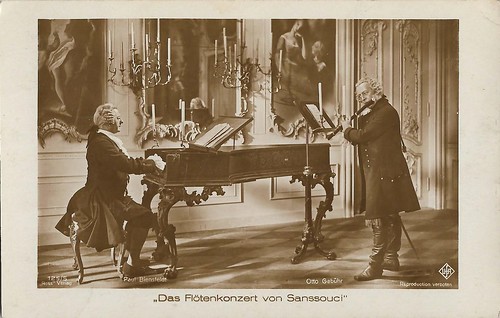
German postcard by Ross Verlag, no. 125/5. Photo: UFA. Publicity still of Das Flötenkonzert von Sanssouci (Gustav von Ucicky, 1930) with Otto Gebühr and Paul Biensfeldt as Johann Joachim Quantz.

German postcard by Ross Verlag, no. 125/6. Photo: Ufa. Otto Gebühr as Frederick the Great in Das Flötenkonzert von Sanssouci/The Flute Concert of Sans-Souci (Gustav Ucicky, 1930), also with Margarete Schön and Olga Engl. This picture is a literal citation of the famous painting Flötenkonzert Friedrichs des Großen in Sanssouci (1850-1852) by Adolph (von) Menzel, now at the Alte Nationalgalerie in Berlin.
In Das Flötenkonzert von Sanssouci/The Flute Concert of Sans-Souci (Gustav von Ucicky, 1930), film audiences heard the voice of Otto Gebühr for the first time. They were so excited by his voice that often the public stood up and applauded as he spoke his first sentence.
Das Flötenkonzert von Sanssouci describes the developments that led to the Seven Years' War. In 1756, an official masquerade ball was celebrated in the Dresden Palais of the Saxon Minister Heinrich von Brühl. Unofficially, however, talks are taking place with the ambassadors of Austria, Russia and France, who are aiming for a plot against the Prussian King Frederick. The Prussian envoy Major von Lindeneck (Hans Rehmann) notices this incident and manages to bring a copy of the concluded secret treaty to the Prussian king (Otto Gebühr).
The king consults his generals, who advise him to be careful. Frederick is stunned by this reaction and develops a counter-plan. For this, he sends Lindeneck again to Dresden. Lindeneck is not very enthusiastic about this assignment because he thinks he doubts his wife Blanche's (Renate Müller) marital fidelity, and that he does not want to leave her alone. However, royal loyalty is more important to him and he carries out all orders of the Prussian king.
When the ambassadors of Austria, Russia and France asked for an audience with Friedrich, he gave, to gain time, a flute concert, which is modelled in its lineup the famous picture of Adolph von Menzel. In the course of this concert, he receives the dispatch from Vienna, which completely reveals the plot. He ends the concert and lets the envoy give the declaration of war. He goes outside and announces that he has just given them the marching orders for the regiments. The Seven Years War begins.
Das Flötenkonzert von Sanssouci provoked fierce protests, as one day before the premiere the anti-war film All Quite on the Western Front (Lewis Milestone, 1930) was banned in Germany. The press criticised that such an anti-war film was banned while Das Flötenkonzert von Sanssouci was screened, which called for war. Especially in the Berlin workers' districts, there were many protests. During a performance at the Excelsior cinema in Neukölln, protesters threw stink bombs and itch powder into the audience and inked the screen. In the Kristallpalast in Wedding, young workers destroyed the windows of the cinema. Workers in the same district tried to cut the electric cables to the Metro Theatre but were stopped by the police. The newspaper Vorwärts sympathised with the protests and called for a boycott of the cinemas that screened the film.
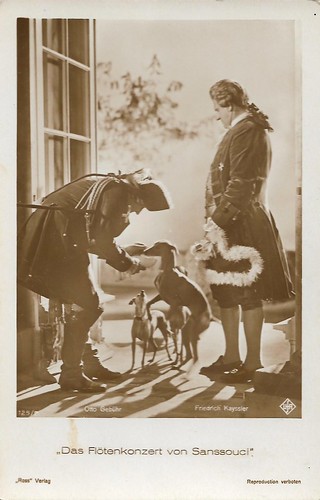
German postcard by Ross Verlag, no. 125/7. Photo: UFA. Publicity still of Das Flötenkonzert von Sanssouci (Gustav von Ucicky, 1930) with Otto Gebühr and Friedrich Kayssler.
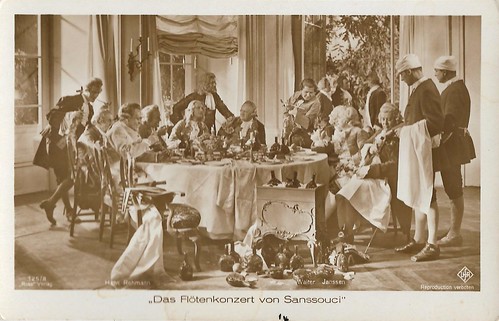
German postcard by Ross Verlag, no. 125/8. Photo: UFA. Publicity still of Das Flötenkonzert von Sanssouci (Gustav von Ucicky, 1930) with Walter Janssen and Hans Rehmann.
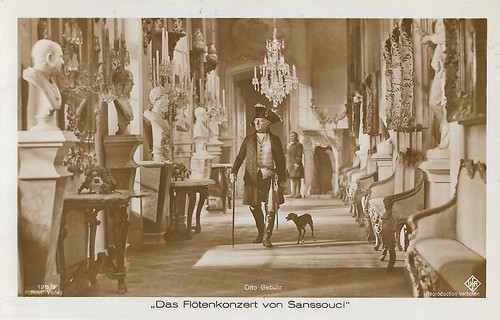
German postcard by Ross Verlag, no. 125/9. Photo: UFA. Publicity still of Otto Gebühr in Das Flötenkonzert von Sanssouci (Gustav von Ucicky, 1930).
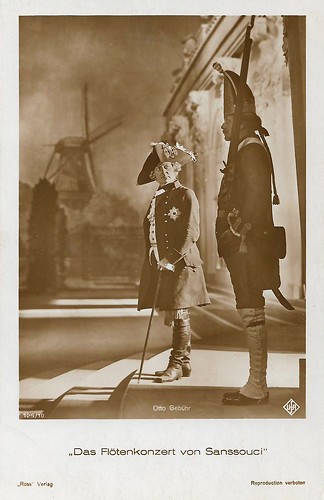
German postcard by Ross Verlag, no. 125/10. Photo: UFA. Publicity still of Das Flötenkonzert von Sanssouci (Gustav von Ucicky, 1930) with Otto Gebühr.

Sanssouci, Potsdam, Berlin, Germany.
Sanssouci Park in Potsdam, Berlin is an ensemble of palaces and garden complexes, which was built under Frederick the Great during the 18th century. It was expanded under Frederick William IV in the 19th century. Frederick the Great wanted to reside there 'sans souci' (= without care) and to follow his personal and artistic interests.

Neues Palais, Sanssouci Park, Potsdam, Berlin, Germany.
Twenty years following his creation of Sanssouci, Frederick the Great built the New Palace (Neues Palais) in the western part of the park. This far larger palace was in direct contrast to the relaxed ethos behind Sanssouci, and displayed Frederick's power and strength to the world, in the Baroque style. The design of the New Palace was intended to demonstrate that Prussia's capabilities were undiminished despite its near defeat in the Seven Years' War. Frederick made no secret of his intention, even referring to the new construction as his 'fanfaronade' (= showing off).
Sources: Wikipedia (German and English) and IMDb.
This post was last updated on 16 June 2024.

German postcard by Ross Verlag, no. 125/1. Photo: Ufa. Otto Gebühr as Frederick the Great in Das Flötenkonzert von Sanssouci/The Flute Concert of Sans-Souci (Gustav Ucicky, 1930).

German postcard by Ross Verlag, no. 125/2. Photo: UFA. Publicity still of Das Flötenkonzert von Sanssouci (Gustav von Ucicky, 1930) with Otto Gebühr, Friedrich Kayssler, Alfred Beierie, and Georg John.

German postcard by Ross Verlag, no. 125/3. Photo: UFA. Publicity still of Das Flötenkonzert von Sanssouci (Gustav von Ucicky, 1930) with Otto Gebühr, Kurt Pehlemann, Alfred Beierie, Friedrich Kühne, Georg John and Friedrich Kayssler. They played respectively: King Frederick the Great, Hans Karl von Winterfeldt, Wolf Friedrich von Retzow, Schwerin, Hans Joachim von Zieten, and Karl Wilhelm von Finckenstein.

German postcard by Ross Verlag, no. 125/4. Photo: Ufa. Otto Gebühr as King Frederick the Great (Friedrich II) of Prussia and Renate Müller as Blanche Lindeneck in the German early sound film Das Flötenkonzert von Sanssouci (Gustav von Ucicky, 1930).

German postcard by Ross Verlag, no. 125/5. Photo: UFA. Publicity still of Das Flötenkonzert von Sanssouci (Gustav von Ucicky, 1930) with Otto Gebühr and Paul Biensfeldt as Johann Joachim Quantz.

German postcard by Ross Verlag, no. 125/6. Photo: Ufa. Otto Gebühr as Frederick the Great in Das Flötenkonzert von Sanssouci/The Flute Concert of Sans-Souci (Gustav Ucicky, 1930), also with Margarete Schön and Olga Engl. This picture is a literal citation of the famous painting Flötenkonzert Friedrichs des Großen in Sanssouci (1850-1852) by Adolph (von) Menzel, now at the Alte Nationalgalerie in Berlin.
Stink bombs and itch powder in the cinema
In Das Flötenkonzert von Sanssouci/The Flute Concert of Sans-Souci (Gustav von Ucicky, 1930), film audiences heard the voice of Otto Gebühr for the first time. They were so excited by his voice that often the public stood up and applauded as he spoke his first sentence.
Das Flötenkonzert von Sanssouci describes the developments that led to the Seven Years' War. In 1756, an official masquerade ball was celebrated in the Dresden Palais of the Saxon Minister Heinrich von Brühl. Unofficially, however, talks are taking place with the ambassadors of Austria, Russia and France, who are aiming for a plot against the Prussian King Frederick. The Prussian envoy Major von Lindeneck (Hans Rehmann) notices this incident and manages to bring a copy of the concluded secret treaty to the Prussian king (Otto Gebühr).
The king consults his generals, who advise him to be careful. Frederick is stunned by this reaction and develops a counter-plan. For this, he sends Lindeneck again to Dresden. Lindeneck is not very enthusiastic about this assignment because he thinks he doubts his wife Blanche's (Renate Müller) marital fidelity, and that he does not want to leave her alone. However, royal loyalty is more important to him and he carries out all orders of the Prussian king.
When the ambassadors of Austria, Russia and France asked for an audience with Friedrich, he gave, to gain time, a flute concert, which is modelled in its lineup the famous picture of Adolph von Menzel. In the course of this concert, he receives the dispatch from Vienna, which completely reveals the plot. He ends the concert and lets the envoy give the declaration of war. He goes outside and announces that he has just given them the marching orders for the regiments. The Seven Years War begins.
Das Flötenkonzert von Sanssouci provoked fierce protests, as one day before the premiere the anti-war film All Quite on the Western Front (Lewis Milestone, 1930) was banned in Germany. The press criticised that such an anti-war film was banned while Das Flötenkonzert von Sanssouci was screened, which called for war. Especially in the Berlin workers' districts, there were many protests. During a performance at the Excelsior cinema in Neukölln, protesters threw stink bombs and itch powder into the audience and inked the screen. In the Kristallpalast in Wedding, young workers destroyed the windows of the cinema. Workers in the same district tried to cut the electric cables to the Metro Theatre but were stopped by the police. The newspaper Vorwärts sympathised with the protests and called for a boycott of the cinemas that screened the film.

German postcard by Ross Verlag, no. 125/7. Photo: UFA. Publicity still of Das Flötenkonzert von Sanssouci (Gustav von Ucicky, 1930) with Otto Gebühr and Friedrich Kayssler.

German postcard by Ross Verlag, no. 125/8. Photo: UFA. Publicity still of Das Flötenkonzert von Sanssouci (Gustav von Ucicky, 1930) with Walter Janssen and Hans Rehmann.

German postcard by Ross Verlag, no. 125/9. Photo: UFA. Publicity still of Otto Gebühr in Das Flötenkonzert von Sanssouci (Gustav von Ucicky, 1930).

German postcard by Ross Verlag, no. 125/10. Photo: UFA. Publicity still of Das Flötenkonzert von Sanssouci (Gustav von Ucicky, 1930) with Otto Gebühr.

Sanssouci, Potsdam, Berlin, Germany.
Sanssouci Park in Potsdam, Berlin is an ensemble of palaces and garden complexes, which was built under Frederick the Great during the 18th century. It was expanded under Frederick William IV in the 19th century. Frederick the Great wanted to reside there 'sans souci' (= without care) and to follow his personal and artistic interests.

Neues Palais, Sanssouci Park, Potsdam, Berlin, Germany.
Twenty years following his creation of Sanssouci, Frederick the Great built the New Palace (Neues Palais) in the western part of the park. This far larger palace was in direct contrast to the relaxed ethos behind Sanssouci, and displayed Frederick's power and strength to the world, in the Baroque style. The design of the New Palace was intended to demonstrate that Prussia's capabilities were undiminished despite its near defeat in the Seven Years' War. Frederick made no secret of his intention, even referring to the new construction as his 'fanfaronade' (= showing off).
Sources: Wikipedia (German and English) and IMDb.
This post was last updated on 16 June 2024.
No comments:
Post a Comment